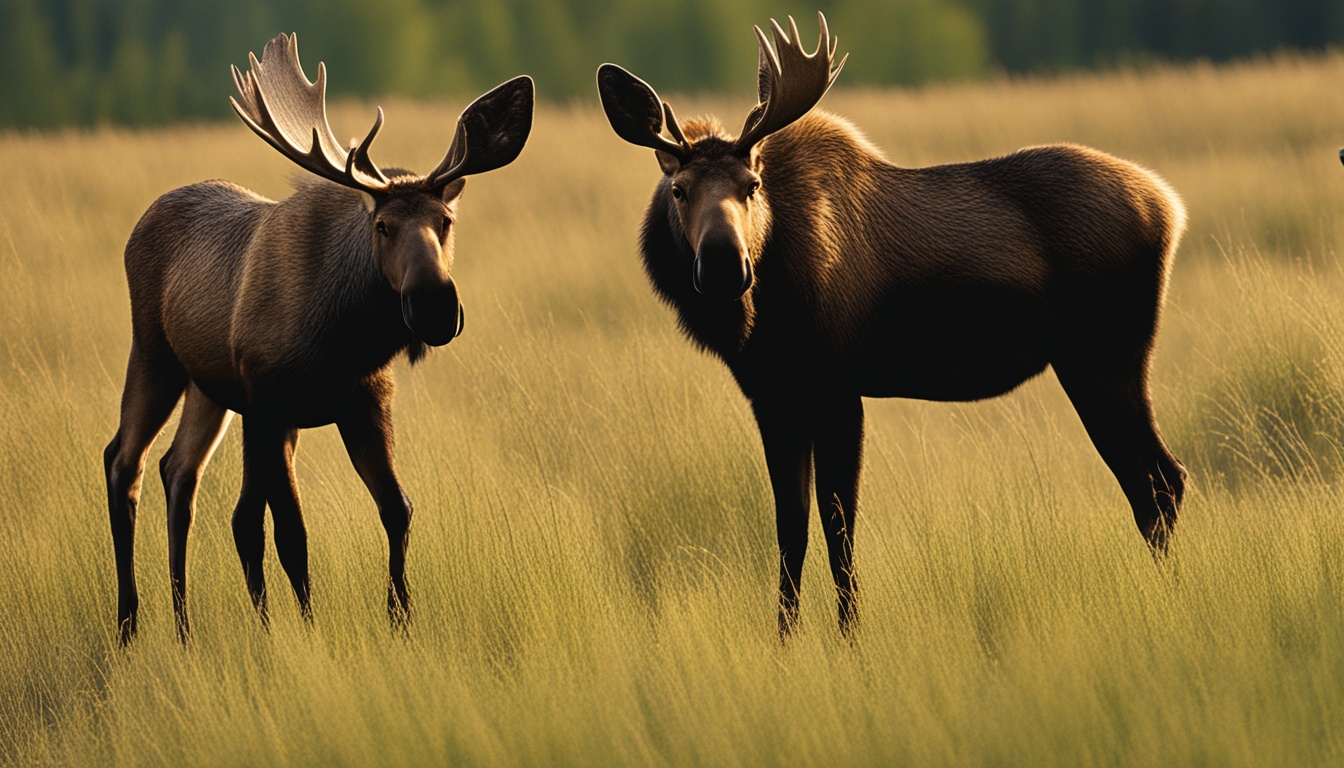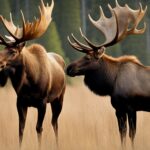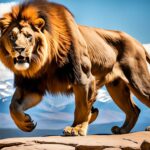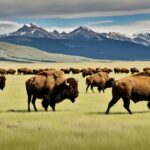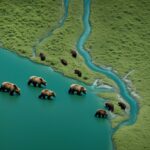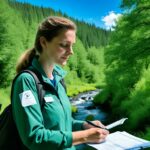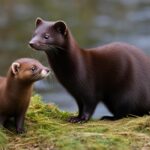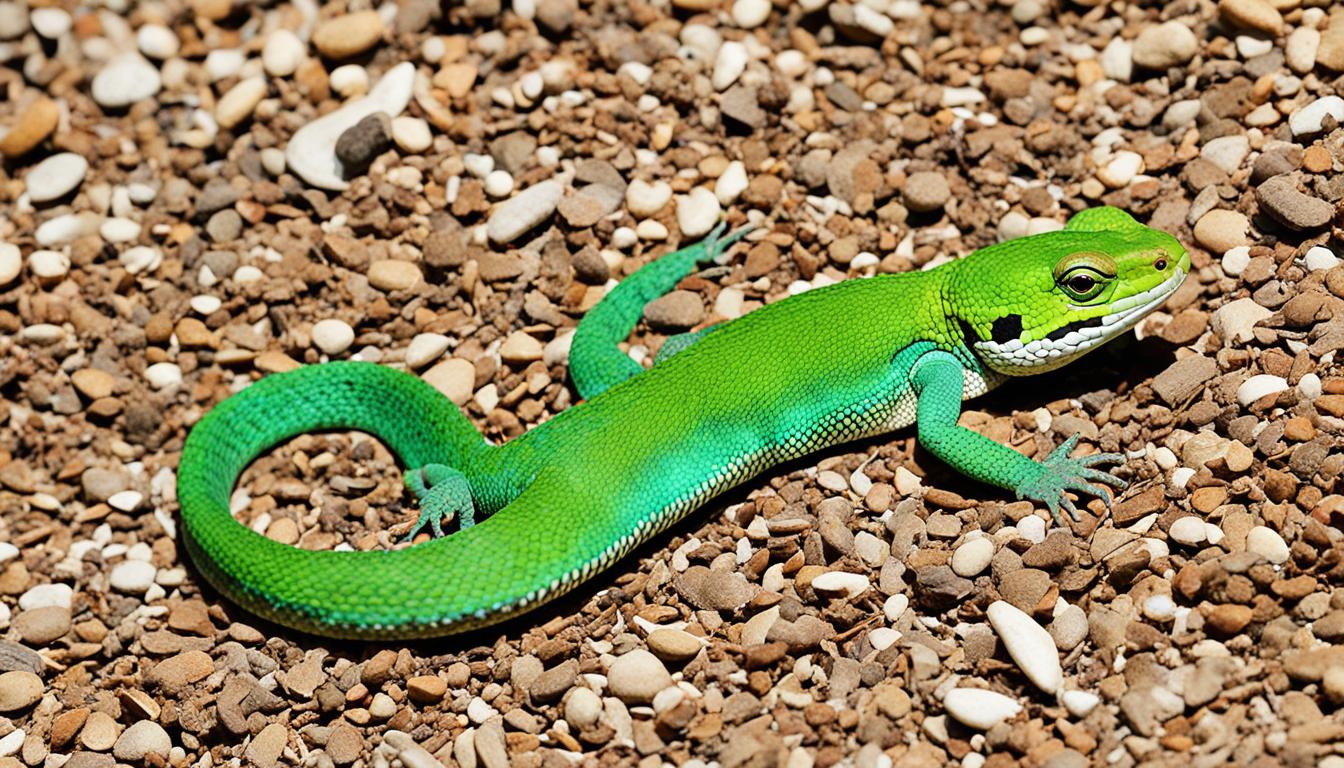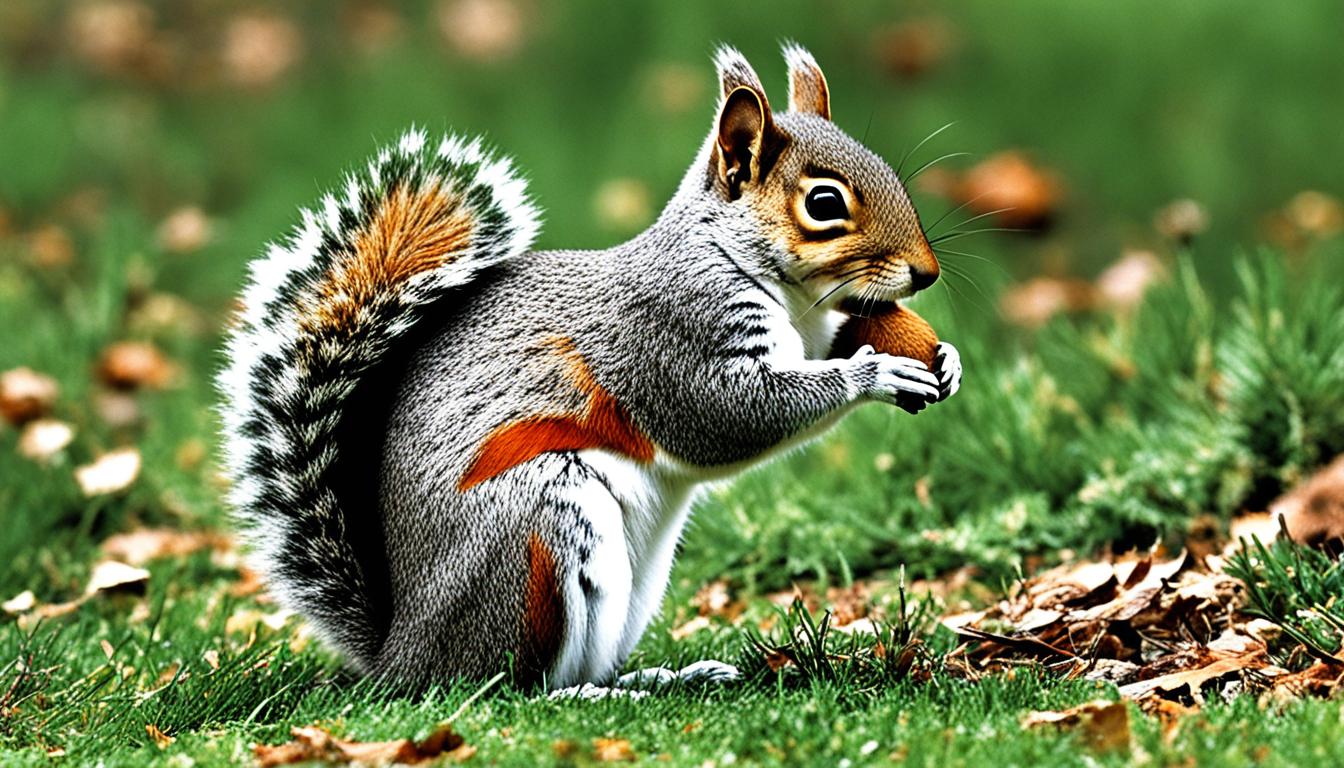Moose and elk are from the deer family. People often mix them up because their antlers fall off and their tracks look alike. But, they’re different in many ways. Moose are huge with a dark brown fur and a swinging, fleshy part under their throats. Elk are lighter, with a tan coat and a tan neck. They like being around others.
When you look at their tracks or antlers, you can see the differences. Moose make deep, heart-shaped tracks. They have flat, wide antlers that look like paddles. On the other hand, elk tracks are pointed like a tooth. Their antlers are tall and have lots of points. It’s key to know these details if you’re trying to spot wildlife or going hunting. This is especially important in areas like Jackson Hole.
Introduction to Moose and Elk
Moose and elk both come from the deer family. They are famous for their large antlers. You can usually spot them in places like Jackson Hole. Tourists and hunters often look for them. It’s important to know how to tell moose and elk apart.
Looking at an elk and moose identification guide shows you their unique looks. Moose are bigger and have a brown coat like chocolate. Elks are lighter and have a dark neck. They both lose their antlers from November to March. This is a special time to learn how to identify them.
Learning elk or moose identification tips can make you better at spotting wildlife. It helps both people who love nature (like DIY lovers) and those who track animals for work. Spotting the differences in antlers and faces is key. For example, moose have round noses, while elk have pointed ones. Knowing these details makes your time in the wild more meaningful. It also helps with responsible hunting.
A good elk and moose identification guide will focus on what sets them apart. This matters for anyone, whether you’re a hunter or just curious, especially in places like Jackson Hole. Being able to tell the animals apart is very important.
Physical Size Comparison
It’s key to know the size difference between moose and elk for spotting them in nature. Moose are the biggest in the deer family, much larger than elk.
Moose Size
A bull moose stands 6 to 7 feet at the shoulders and weighs over 1,000 pounds. They’re some of the biggest animals in places like Colorado. Even cow moose, which are a bit smaller, are larger than cow elk.
This big size helps tell moose and elk apart.
Elk Size
On the other hand, a bull elk is about 4 to 5 feet high at the shoulders and weighs some 600 pounds. This big difference in size makes it easier to notice the elk’s unique characteristics. Female elk are also not as big as cow moose.
Finding these size clues is key to identifying them correctly.
Habitat and Distribution
It’s tough to tell a moose from an elk based on where they live. Moose and elk often live in the same places, like forests and mountains. This makes it hard to tell the two apart just by their homes.
But, there are some big differences in where they like to be. Young bull moose have started showing up more in southwest Colorado. This happened because people brought them back there in the early 1990s. Now, the moose there have grown in number and are all over the place.
| Characteristic | Moose | Elk |
|---|---|---|
| Preferred Habitat | Forests and wetlands | Forests and open meadows |
| Distribution in Colorado | Southwest regions, growing population | Widespread, especially in mountainous areas |
| Reintroduction Success | Significant growth since the 1990s | Stable populations across several regions |
Knowing where moose and elk like to be can help you tell them apart. Focus on their habitat to get better at spotting the differences between them.
Coat Color and Texture
Coat color and texture are key in telling moose and elk apart. Knowing these details helps with spotting them from far away.
Moose Coat Characteristics
Moose have a dark, chocolate brown coat without a lighter rump. This deep brown is very noticeable in forests. Their coats are thick and rough, keeping them warm in cold weather.
Elk Coat Characteristics
Elk, on the other hand, have a reddish or light brown coat. They also have a white rump patch that moose lack. Elk’s coats are sleek and not as rough, suited for their activity and living spaces. These unique features help tell elk and moose apart.
| Feature | Moose | Elk |
|---|---|---|
| Primary Coat Color | Dark Chocolate Brown | Reddish to Lighter Brown |
| Rump Color | No Lighter Rump Color | Lighter Rump Patch |
| Coat Texture | Thick and Coarse | Sleeker and Less Coarse |
Noticing the differences in coat color and texture helps in identifying moose and elk. This is important for accurate wildlife spotting.
Antlers: Shape and Growth Patterns
It’s important to know the shapes and growth of moose and elk antlers. This knowledge is key, especially during hunting season, for clear identification of these animals. Their unique features are what make them stand out from each other.
Moose Antlers
Moose antlers are instantly recognizable. They have a wide, flat shape like a paddle, with pointed ends. These antlers grow sideways from the moose’s head. This makes them large and impressive.
Elk Antlers
Elk antlers look quite different from moose antlers. Unlike moose antlers, which grow outwards, elk antlers grow towards the back. They have a main beam with lots of points. This growth style shows the beauty and intricacy of elk antlers.
| Feature | Moose | Elk |
|---|---|---|
| Antler Shape | Paddle-like | Main beam with multiple points |
| Orientation | Sides of the head | Backwards over the body |
Facial Features and Noses
Knowing the difference between a moose and an elk is key when looking at wildlife or hunting. One easy way to tell them apart is by their faces. Look at the shape of their noses and if they have a dewlap or bell under their jaw.
- Moose Noses: Moose have a nose that’s more circular. This look is made more unique by a flappy piece of skin called a dewlap, hanging from their jaw.
- Elk Noses: On the other hand, elks have more of a pointy nose. They don’t have a dewlap, so their neck and jaw look smoother.
These nose and jawline features go for both male and female moose and elk. Spotting these details can help you correctly identify these animals. This makes your time out in wildlife more enjoyable.
| Feature | Moose | Elk |
|---|---|---|
| Nose Shape | Rounded | Pointed |
| Dewlap Presence | Yes | No |
Compare Moose and Elk Sounds and Calls
When you listen to moose and elk, it’s key to know the unique sounds they make. They use these sounds to talk to each other during mating times and to warn of dangers.
Moose have deep, rough calls. Their mating calls are loud and deep, trying to get the attention of female moose and show they’re the boss.
Elk, on the other hand, make high-pitched bugles. These sounds can be heard from far away. During mating season, a bull elk’s call changes from deep to high tones, trying to win over females and warn other males.
| Moose Calls | Elk Calls |
|---|---|
| Deep, guttural grunts | High-pitched bugles |
| Primarily during mating season | Rutting season calls with mixed tones |
| Low-frequency sound waves | High-frequency sound waves |
Knowing the sounds of moose and elk can make watching them even more exciting. It lets you correctly pick out these amazing animals. Learning the difference between elk vs moose calls adds a fun touch to seeing them in the wild.
Behavioral Differences
It’s not hard to spot the difference between a moose and an elk if you pay attention to their actions. Even though both are deer, their ways of living are very different, especially in how they interact with others.
Social Structure of Moose
Moose usually like to be alone. You’ll often see them by themselves out in nature. The only time you might find more than one moose together is if it’s a mother and her young ones. This behavior helps you know if you’re looking at a moose or something else.
Social Structure of Elk
Elk, on the other hand, prefer to be surrounded by others. They can be found in groups, which can vary in size. Sometimes you’ll see just a few of them hanging out, especially during mating season. Other times, you might spot a big, mixed group of elks. This gregarious lifestyle is a key clue to telling elk apart from moose.
| Behavioral Cues | Moose | Elk |
|---|---|---|
| Group Structure | Solitary except with calves | Gregarious, seen in groups |
| Social Interaction | Limited | Frequent |
Track and Hoof Print Differences
It’s key to know the differences between moose and elk track and hoof prints. Moose have deep, heart-shaped tracks due to their big bodies. Elk tracks are shaped like teeth and not as deep. This helps in tracking them in the wild or for hunting.
Moose make deep tracks because they’re heavier. But elk tracks are shallower and narrower. Knowing these points can help you spot these animals in nature.
| Feature | Moose Tracks | Elk Tracks |
|---|---|---|
| Shape | Heart-shaped | Tooth-shaped |
| Depth | Deeper | Shallower |
| Size | Larger | Smaller |
Always look at the environment and animal habits when seeing tracks. This helps you become better at tracking. And, it teaches you more about these amazing animals.
How do you tell the difference between a moose and an elk?
Knowing how to spot the difference between a moose and an elk is key. It’s important to notice their unique looks and actions. If you love nature or hunting, a good elk vs moose identification guide is a big help.
Moose are usually bigger than elk. A bull moose can be as tall as 7 feet at the shoulders. In comparison, a bull elk is about 4 to 5 feet tall. Their size is a big clue.
Their coat color also sets them apart. Moose have a dark, chocolate brown coat. Elk, on the other hand, have a lighter, reddish-brown coat. You can see this color difference well from afar, which is a handy tip for identifying moose and elk.
Their antlers look different too. Moose antlers are wide with a flat top, like a paddle. Elk antlers are narrower but longer, with points. This is an important detail for anyone with an elk vs moose identification guide looking for them during hunting season.
Don’t overlook the shape of their noses and a dewlap. A moose has a rounded nose and a dewlap under its throat. Elk, however, have a straighter nose and no dewlap.
Looking at track patterns can also give you a clue. Because moose are heavier, their tracks tend to be deep and shaped like a heart. Elk prints are less deep and look more like a line. For hunters and trackers, finding and reading these tracks is useful.
Knowing these details is important for both watching wildlife and for hunting. It helps hunters avoid mixing them up.
Common Misidentifications
It’s easy to mix up a young bull moose with a bull elk. This mistake happens a lot now because young moose are growing in number in various places. It’s really important to know the key differences between a moose and an elk. For example, young bull moose are beefier and heavier than bull elk.
Young Bull Moose vs. Bull Elk
Often, young bull moose and bull elk are thought to be the same. This is because they live in similar areas and can be close in size. Look at their antlers and body shape to know for sure. Moose have wide, paddle-like antlers, while elk antlers go backwards.
Cow Moose vs. Cow Elk
Telling cow moose from cow elk is also tricky. Size, color, and facial features are what to focus on. Cow moose are bigger and darker, with a noticeable dewlap under their chin. On the other hand, cow elk are smaller and have a lighter, reddish-brown fur, but no dewlap. This is really critical for hunters to get right.
| Feature | Young Bull Moose | Bull Elk |
|---|---|---|
| Body Build | Muscular and Stocky | Leaner |
| Antlers | Paddle-like | Project Backward |
| Feature | Cow Moose | Cow Elk |
| Size | Larger | Smaller |
| Coat Color | Darker Brown | Lighter Reddish-Brown |
| Dewlap (Under Chin) | Present | Absent |
Importance of Proper Identification in Hunting
It’s vital for hunters to name game species right. This helps avoid legal problems and supports nature. Wildlife experts, like Colorado Parks and Wildlife, say knowing species is key.
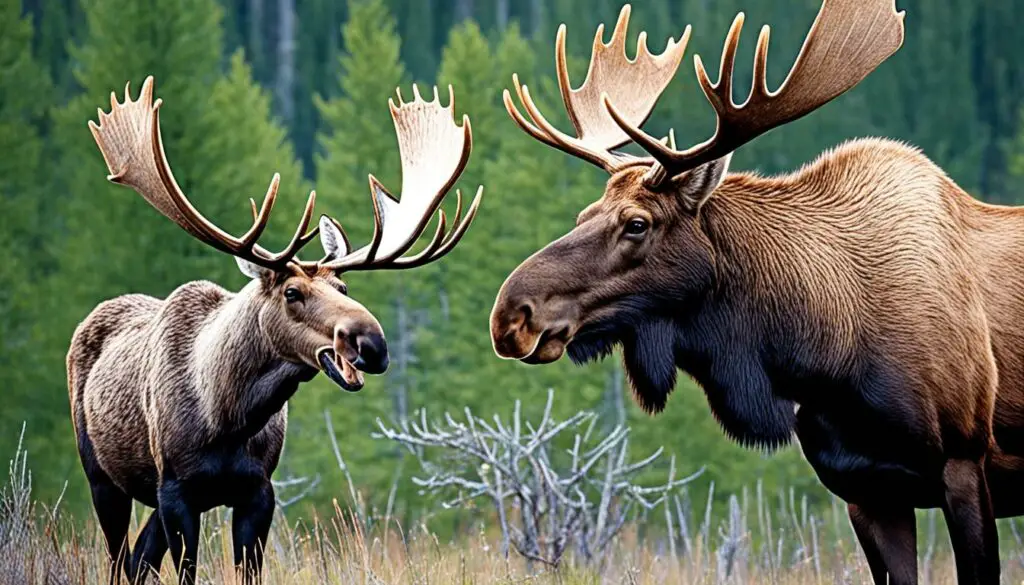
Tips for Hunters
It’s wise for hunters to learn good hunting identification tips. They should know how to spot differences between moose and elk. Size, antlers, and coat color are key.
Experts recommend learning from books and local advice. They say to focus on what makes moose and elk different. Knowing this helps avoid mistakes.
Elk roam in groups, moose prefer being alone. This is another clue for telling them apart.
Conservation and Reporting Mistakes
Doing hunting right supports saving wildlife and follows the law. Errors happen but telling the authorities quickly is a must. This helps keep nature in balance.
By using good ID skills and being ethical, hunters help the planet. It also makes the hunting world better for everyone.
Conclusion: Appreciating Moose and Elk in the Wild
It’s key to know how to tell moose and elk apart. This makes your time observing them better. It also ensures you’re being ethical when watching wildlife. Learn about their size, color, antlers, and faces. This will help you make smart choices when you’re out in their home.
Understanding moose and elk makes you respect them more. Knowing them well is good for the animals. It helps with hunting and keeping them safe. Plus, it makes your nature adventures richer. You notice what makes each one special.
No matter if you’re a visitor, nature lover, or hunter, knowing the differences is important. It’s good for the animals and for your nature experiences. This shows how important it is to enjoy wildlife the right way.

